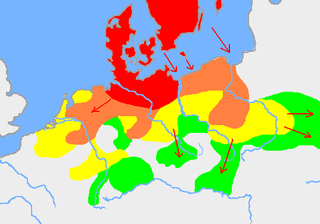Related Research Articles

Edward Estlin Cummings, commonly known as e e cummings or E. E. Cummings, was an American poet, painter, essayist, author, and playwright. During World War I he worked as an ambulance driver and was imprisoned in an internment camp, which provided the basis for his novel The Enormous Room (1922). The following year he published his first collection of poetry, Tulips and Chimneys, which showed his early experiments with grammar and typography. He wrote four plays; HIM (1927) and Santa Claus: A Morality (1946) were most successful. He wrote EIMI (1933), a travelogue of the Soviet Union, and delivered the Charles Eliot Norton Lectures in poetry, published as i—six nonlectures (1953). Fairy Tales (1965), a collection of short stories, was published posthumously.
Latin phonology is the system of sounds used in various kinds of Latin. This article largely deals with what features can be deduced for Classical Latin as it was spoken by the educated from the late Roman Republic to the early Empire. Evidence comes in the form of comments from Roman grammarians, common spelling mistakes, transcriptions into other languages, and the outcomes of various sounds in the Romance languages.
Transliteration is a type of conversion of a text from one script to another that involves swapping letters in predictable ways, such as Greek ⟨α⟩ → ⟨a⟩, Cyrillic ⟨д⟩ → ⟨d⟩, Greek ⟨χ⟩ → the digraph ⟨ch⟩, Armenian ⟨ն⟩ → ⟨n⟩ or Latin ⟨æ⟩ → ⟨ae⟩.

X, or x, is the twenty-fourth letter of the Latin alphabet, used in the modern English alphabet, the alphabets of other western European languages and others worldwide. Its name in English is ex, plural exes.

Y, or y, is the twenty-fifth and penultimate letter of the Latin alphabet, used in the modern English alphabet, the alphabets of other western European languages and others worldwide. According to some authorities, it is the sixth vowel letter of the English alphabet. Its name in English is wye, plural wyes.
The circumflex is a diacritic in the Latin and Greek scripts that is also used in the written forms of many languages and in various romanization and transcription schemes. It received its English name from Latin: circumflexus "bent around"—a translation of the Greek: περισπωμένη.

Et in Arcadia ego is a 1637–38 painting by Nicolas Poussin (1594–1665), the leading painter of the classical French Baroque style. It depicts a pastoral scene with idealized shepherds from classical antiquity, and a woman, possibly a shepherdess, gathered around an austere tomb that includes the Latin inscription "Et in Arcadia ego", which is translated to "Even in Arcadia, there am I"; "Also in Arcadia am I"; or "I too was in Arcadia". Poussin also painted another version of the subject in 1627 under the same title.
Italian orthography uses 21 letters of the 26-letter Latin alphabet to write the Italian language. This article focuses on the writing of Standard Italian, based historically on the Florentine dialect, and not the other Italian dialects.
Early Modern English or Early New English (ENE) is the stage of the English language from the beginning of the Tudor period to the English Interregnum and Restoration, or from the transition from Middle English, in the late 15th century, to the transition to Modern English, in the mid-to-late 17th century.

Matthew 3:17 is the seventeenth verse of the third chapter of the Gospel of Matthew in the New Testament. Following Jesus' baptism by John the Baptist, a voice from heaven states that Jesus is "God's beloved son".
French orthography encompasses the spelling and punctuation of the French language. It is based on a combination of phonemic and historical principles. The spelling of words is largely based on the pronunciation of Old French c. 1100–1200 AD, and has stayed more or less the same since then, despite enormous changes to the pronunciation of the language in the intervening years. Even in the late 17th century, with the publication of the first French dictionary by the Académie française, there were attempts to reform French orthography.
Ancient Greek phonology is the reconstructed phonology or pronunciation of Ancient Greek. This article mostly deals with the pronunciation of the standard Attic dialect of the fifth century BC, used by Plato and other Classical Greek writers, and touches on other dialects spoken at the same time or earlier. The pronunciation of Ancient Greek is not known from direct observation, but determined from other types of evidence. Some details regarding the pronunciation of Attic Greek and other Ancient Greek dialects are unknown, but it is generally agreed that Attic Greek had certain features not present in English or Modern Greek, such as a three-way distinction between voiced, voiceless, and aspirated stops ; a distinction between single and double consonants and short and long vowels in most positions in a word; and a word accent that involved pitch.
The circumflex (ˆ) is one of the five diacritics used in French orthography. It may appear on the vowels a, e, i, o, and u, for example â in pâté.

Portuguese orthography is based on the Latin alphabet and makes use of the acute accent, the circumflex accent, the grave accent, the tilde, and the cedilla to denote stress, vowel height, nasalization, and other sound changes. The diaeresis was abolished by the last Orthography Agreement. Accented letters and digraphs are not counted as separate characters for collation purposes.
The traditional English pronunciation of Latin, and Classical Greek words borrowed through Latin, is the way the Latin language was traditionally pronounced by speakers of English until the early 20th century. Although this pronunciation is no longer taught in Latin classes, it is still broadly used in the fields of biology, law, and medicine.

Gothic is an extinct East Germanic language that was spoken by the Goths. It is known primarily from the Codex Argenteus, a 6th-century copy of a 4th-century Bible translation, and is the only East Germanic language with a sizeable text corpus. All others, including Burgundian and Vandalic, are known, if at all, only from proper names that survived in historical accounts, and from loanwords in other, mainly Romance, languages.
A line is a unit of writing into which a poem or play is divided: literally, a single row of text. The use of a line operates on principles which are distinct from and not necessarily coincident with grammatical structures, such as the sentence or single clauses in sentences. Although the word for a single poetic line is verse, that term now tends to be used to signify poetic form more generally. A line break is the termination of the line of a poem and the beginning of a new line.

Quod scripsi, scripsi is a Latin phrase. It was most famously used by Pontius Pilate in the Bible in response to the Jewish priests who objected to his writing "King of the Jews" on the sign (titulus) that was hung above Jesus at his Crucifixion. It is mostly found in the Latin Vulgate Bible. It is equivalent to the Latin expression Dixi, meaning that the speaker has spoken and there is no more to be said.
The Black Country dialect is spoken by many people in the Black Country, a region covering most of the four Metropolitan Boroughs of Dudley, Sandwell, Walsall and Wolverhampton. The traditional dialect preserves many archaic traits of Early Modern English and even Middle English and may be unintelligible for outsiders. This dialect is distinct from and maintains more traditional characteristics than the dialect of Birmingham, which has been more influenced by standard English due to having been urban for a longer time. It has also influenced the accents of the towns and villages in the counties to the north, south and west of the region.
Diaeresis is a name for the two dots diacritical mark as used to indicate the separation of two distinct vowel letters in adjacent syllables when an instance of diaeresis occurs, so as to distinguish from a digraph or diphthong.
References
- ↑ Richard Kostelanetz (15 May 2017). "E. E. Cummings's Long-Forgotten Artist's Book". Hyperallergic. Retrieved 7 January 2023.
- ↑ David Sider (October 2014). "Art Without Words: Cummings' CIOPW". Spring. New Series (21–22). E. E. Cummings Society: 220–224. JSTOR 44114895.